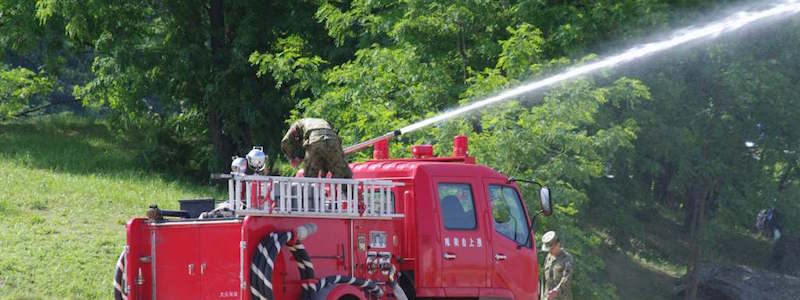Table of Contents
Disaster Prevention
Earthquakes
Earthquake Intensity (Shindo)
In addition to the standard magnitude scale, a seismic intensity scale unique to Japan known as “Shindo” (震度) is used. Earthquakes are rated on a scale from 0 (the weakest) up to 7 (the strongest). Shindo 5 and 6 are divided into “lower” and “upper”, creating 10 levels in total.The Great East Japan Earthquake of 2011 measured 7 in certain areas.
Earthquake Early Warning
When the seismic intensity of an earthquake is estimated as Lower 5 or above, the JMA (Japanese Meteorological Agency) sends an emergency dispatch (Kinkyu Jishin Sokuho, 緊急地震速報, Earthquake Early Warning/EEW) to the general public causing alarms to ring on mobile phones, televisions and radios. Immediately after an earthquake occurs, the JMA relays information on the epicenter, magnitude, and expected impact times and intensity to surrounding regions. When the early warning alarm rings, it is important to take cover in a calm and orderly manner.
Disaster Preparations
Follow these instructions to prevent unnecessary damage, harm and confusion in the event
of a major earthquake.
Home
Keep all exits and corridors clear and be aware of items that can break or topple over.
Be aware of the emergency routes of your building.
Fire is one the most common secondary earthquake disasters. Learn the locations of fire extinguishers and how to use them.
Prepare evacuation goods (see Emergency Survival Kit).
Evacuation Planning
As transportation halts are common, plan a walking route home from your place of work/school.Visit your local city/ward office for maps showing evacuation sites, temporary shelters and support stations near you. Identify your nearest evacuation site, and let family members know where to go and how best to communicate, so you can meet up should you be separated when an earthquake strikes. (see P.4 Communication)
Emergency Survival Kit
It is recommended that you prepare an emergency survival kit, and keep it somewhere
accessible in an emergency. Three days’ worth of food and water should be included for each member of the family. Complete survival kits can be bought online and from lifestyle goods stores. (see P.2 Emergency Survival Kit)
Evacuation Facilities
Following a major earthquake, public transport suspensions are common, and homes may be
rendered unsafe for habitation. The following facilities are in place to assist stranded commuters and those who have lost their homes after a disaster.
Evacuation sites:
Parks and open spaces that are safe from debris and fires. These are generally the first port of call when evacuating from an earthquake.
Support stations:
Shops and facilities which offer free water, toilet facilities and information to assist those who making their way home on foot after a disaster. Look for the marks below. Often street side vending machines will also be opened up, fee of charge.


Potential temporary shelters:
Public buildings that may be opened for the use of those stranded by suspension of transport services etc. Basic food, drink and access to emergency phones are provided. Evacuees can stay for a maximum of 3 days, once the facility has been deemed safe.
Shelters:
Public buildings like schools where those who have lost their homes can stay, usually for a number of weeks.
When an Earthquake Strikes
DON’T PANIC!
Remain calm, move quickly but carefully, and follow instructions from the authorities.
 At home:
At home:
Take cover under a sturdy table or desk.Once the tremor stops, immediately extinguish any open flames (stoves, heaters, candles, etc.), and turn off breakers and gas valves before evacuating.
 Outdoors:
Outdoors:
Beware of debris from damaged buildings, telephone poles, traffic lights, falling
glass, billboards, etc., and make your way to an open space. Avoid walking in roadways whenever possible.
 Theatres/Stadiums:
Theatres/Stadiums:
Await instructions broadcast over PA systems. Do not rush straight for emergency exits.
 Trains and subways:
Trains and subways:
Hold onto handrails and straps, and beware of sudden stops and falling items from the luggage rack.
 While driving:
While driving:
Pull to a stop on the left side of the road. If a parking lot or other open area is available, it is better to stop there. Once the tremor stops, exit your car and begin evacuating on foot. Leave the keys and keep doors unlocked.
 Shops and buildings:
Shops and buildings:
Move away from glass, lighting fixtures or display shelves. Wait in stairwells or
near walls/support pillars. When evacuating, follow the instructions given by those in charge. Do not use elevators or escalators. If you are in an elevator, press buttons for all floors and get off at the first you stop at. Evacuate via the stairs.
 Coastal regions:
Coastal regions:
Evacuate to higher ground immediately. Tsunamis can occur anywhere from minutes to hours after an earthquake. If ocean water recedes suddenly, it may indicate a tsunami is imminent. Wait for an all clear from official sources before returning.


